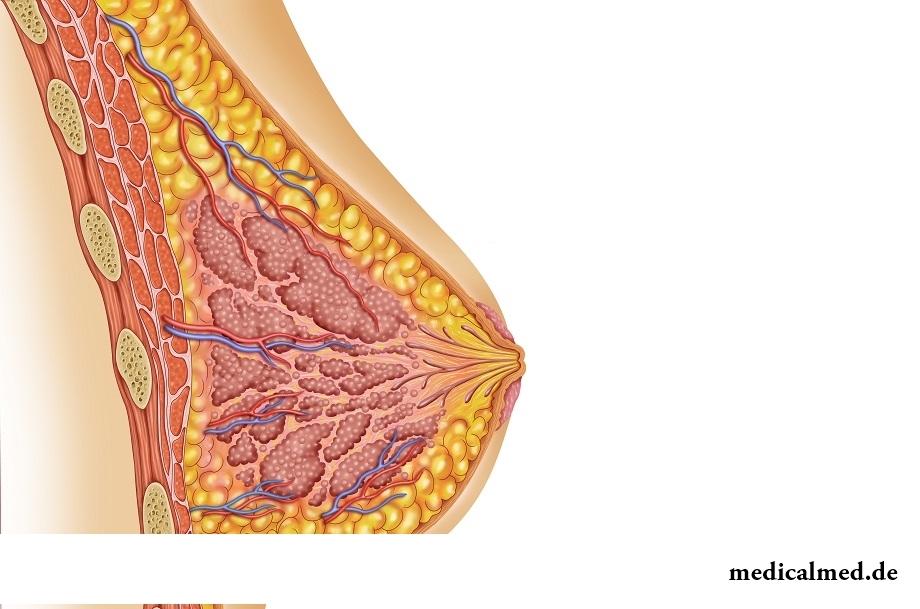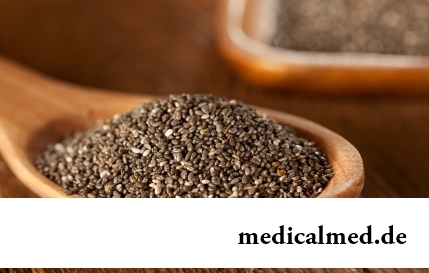





Mammary glands
Mammary glands – pair ferruterous bodies which at women after the delivery form milk and remain underdeveloped with men.

Structure of mammary glands
The size and form of glands are individual, extents of development of outside sexual characters, a menstrual cycle depend on age. On the front surface of a thorax they are located kpered from big chest and front gear muscles.
Each mammary gland contains 15-25 ferruterous segments divided among themselves by layers of connecting fabric and a fatty tissue in which there pass nerves and vessels. Glands reach a limit with canals which radially meet to a nipple and open on its top. In a final piece of lacteal channels there are expansions – lacteal sine which serve as a peculiar tank for the milk which is formed in alveoluses.
The nipple and peripapillary circle are pigmented and have many nerve terminations. On a peripapillary circle in the form of hillocks sweat and sebaceous glands open. Mammary glands krovosnabzhatsya by an extensive network of vessels.
Research of a mammary gland
Begin studying of body with inquiry about puberty terms, formation of periods, about the number of pregnancies, childbirth whether the woman after the delivery and as long, about hereditary burdeness on tumoral adenoses nursed. The woman can show complaints that the mammary gland hurts or from a nipple there are allocations.
After inquiry the mammary gland is carefully examined in vertical and horizontal position. At survey estimate the size, a form, symmetry of an arrangement of glands, swelling of mammary glands, a condition of a nipple and a peripapillary circle, degree of shift of mammary glands at the movement by hands, vascular network on skin.
The sliding palpation of mammary glands allows to estimate their mobility in relation to skin and the subject fabrics, to reveal pathological allocations from a nipple, deformations of a nipple, consolidation of an areola. The research of the lymph nodes tied with glands – axillary and subclavial is obligatory.
Transillumination of glands helps to find the pathological centers in them. More informative method of a research – ultrasonic, it is recommended to carry out at suspicion of a disease of mammary glands at women to 30 years, at more advanced age mammography is shown. On x-ray films at mammography in case of pathology blackouts which size and an arrangement can be established precisely are found.
Diseases of a mammary gland and approaches to treatment
The following pathological processes can affect a mammary gland:
- Inflammatory and infectious;
- Dishormonal;
- Tumoral;
- Traumatic damages.
Mastitis – an inflammatory disease most of which often develops at women during feeding by a breast. Pathogenic bacteriums (staphylococcus, streptococci, etc.) get into a mammary gland on channels or through nipple cracks, causing in it an inflammation. The disease proceeds against the background of feeling sick of the woman, high temperature of a body, swelling of mammary glands and increase in their size is noted, at palpation consolidations and morbidity are defined. Upon transition of an inflammation to a purulent phase on skin there can be a local reddening and a softening. Treatment of a mammary gland at mastitis is carried out under observation of the surgeon, begin with conservative measures, antibiotics, desintoxication surely join. At purulent mastitis surgical intervention is required.
From other infectious and inflammatory adenoses thrombophlebitis of their venous network, tuberculosis, echinococcosis, etc. meet.
Galactorrhoea – any release of milk from mammary glands. This quite frequent and absolutely physiologic phenomenon at a lactation when at suction of one breast from the second release of milk as a sign of establishment of a lactation at the sufficient level begins. If release of milk happens out of the breastfeeding period, then it is the pathology connected with a hormonal imbalance and strengthened by products of hormone of prolactin. Treatment of mammary glands in this case is based on recovery of hormonal balance, is carried out together with the endocrinologist.
From tumoral diseases of mammary glands allocate high-quality and malignant processes. Carry a fibrous and cystous mastopathy and a fibroadenoma to high-quality. At these states the mammary gland hurts depending on a phase of a menstrual cycle. Treatment at initial stages includes hormonal, homeopathic remedies, surgical intervention with a sectoral resection of a part of gland is required later, removal of a mammary gland entirely, as a rule, is not required.
From malignant defeats cancer is on the first place. In its emergence heredity, age of approach of the first pregnancy, feeding duration a breast, etc. play a role. Danger of cancer of mammary glands consists in bystry distribution of metastasises. The long asymptomatic period results in late detectability of pathology. Most often the tumor is found the woman accidentally, during disguise, washing of a body. Generally process strikes only one gland, in the second there are already tumor metastasises.
Most often nodal and diffusion forms of defeat meet. Nodal cancer is usually localized in the central area and a verkhnenaruzhny quadrant, it is possible to probe mobile dense roundish education with accurate edges. Over it there can be changes of skin in the form of pastosity, "a lemon crust", retraction of a nipple. Diffusion cancer is not probed accurately, at its various versions mobility of skin can decrease, and the mammary gland shrivels and decreases. Crucial importance in diagnosis plays a cytologic and histologic research of a bioptat.
Approaches to therapy of cancer depend on a stage – at early stages perhaps only surgical removal of a mammary gland, in other stages it is required to combine it with beam and chemotherapy.
The most high temperature of a body was recorded at Uilli Jones (USA) who came to hospital with a temperature of 46,5 °C.

Separate food - the system of meal based on digestion physiology which is carried to improvement methods. In opinion д...
Section: Articles about health
The dietology, as well as other sciences, does not stand still. Food stuffs are exposed to comprehensive study, and scientists obtain new information on their properties and influence on a human body. Unfortunately, this reasonable and natural process from time to time д...
Section: Articles about health
Eyes – unique body on the structure thanks to which the person obtains about 80% of information on the world around: about a form, color, size, the movement, and also many other parameters of objects or phenomena. But whether much we know about the most valuable sense body which, according to the scientist Sechenov, provides us about one thousand various feelings a minute? Let's consider 10 most surprising facts about eyes and sight....
Section: Articles about health
Dogrose – one of the most widespread adornment and medicinal plants growing practically in all territory ours...
Section: Articles about health
Striya (extension) are the defects of skin having an appearance of direct or wavy strips from 1 to 10 cm long and 1-5 mm wide. In most cases at women of a striya are located on a stomach, hips, a breast or buttocks. At athletes they can appear on shoulders and внутренн...
Section: Articles about health
The main role in development of a peptic ulcer of a stomach and duodenum the bacterium Helikobakter plays pilor. Activity and the strengthened reproduction of this microorganism lead to weakening of protection of mucous membranes and their erosive damage. Displays of an illness seriously reduce quality of life: patients regularly test attacks of severe pain, heartburn, nausea. On this background also psychoemotional malfunctions develop: a kidney-vetch, as a rule, shows an acrimony, ча...
Section: Articles about health
Small appetite at the child – the complaint which pediatricians should hear practically from each mother. Most often it is carried to разр...
Section: Articles about health
Frosty air, fresh wind and easy snowball at most of Russians are associated with cheerfulness, health and cheerful entertainments on which our winter is so generous. But, unfortunately, cold season sometimes brings also troubles with health. It is not about a season...
Section: Articles about health
Not everyone can brag of the shining Hollywood smile. Even the person who is regularly visiting the stomatologist and watching of oral cavities over health periodically has problems: enamel of teeth darkens under the influence of some products, on it the deposits giving to teeth a grayish or yellowish shade collect....
Section: Articles about health
Very often as a source of the infection which caused a disease serves our house - the place which a priori has to be safe. However...
Section: Articles about health
Each person has easy indispositions which he transfers "standing", trying not to ask for medical care. Arguments at the same time are adduced same: "it is a trifle, itself will pass", "I have too many important issues", "there are no wish to spend time on...
Section: Articles about health
The person, as well as all other beings living on our planet feels weather changing. It is the normal meteosensitivity which is not causing to healthy people of special troubles. Meteodependence, on the contrary, is the morbid condition which is characterized by an exacerbation of chronic illnesses at change of air temperature, differences of atmospheric pressure, wind strengthening, magnetic storms and other "surprises" on which the nature is so generous. The people suffering from meteodependence have to з...
Section: Articles about health
With age in a human body harmful substances collect. We receive them with food and water, at inhalation contaminated air...
Section: Articles about health
The state of health of the person depends on many factors. One of the most important is the constant, but not exhausting a physical activity. In the presence of various illnesses specialists often advise patients to do swimming which by right borrows ведущ...
Section: Articles about health
Health and attractiveness - eternal values, pursuing which people often use the most unusual ingredients and technicians. Let's consider 11 most exotic and sometimes not most pleasant Spa procedures to which the person in a pursuit of beauty and youth agrees....
Section: Articles about health
One of the useful properties presented to the person by the nature is ability to feel fear. This ability is called a signal...
Section: Articles about health
It is impossible to imagine human life in which there would be no plants. Practically in each apartment and any production room there are window plants, millions of people with pleasure are engaged in gardening and truck farming, many citizens пр...
Section: Articles about health
More than a half of the married couples which faced prostatitis – leave. The new broadcast "Female View of Prostatitis" will help to learn – whether you have or your relatives problems....
Section: Articles about health
Quite large number of people adheres to the principles of vegetarian food. But how to be if in a family of vegetarians is д...
Section: Articles about health
Physical activity is necessary for normal functioning of a human body. At a lack of the movement joints cease to function, muscles atrophy, cardiovascular activity is broken and the metabolism worsens. Modern городс...
Section: Articles about health
Each person supports all life a SARS about 200 times. The peak of incidence falls on cold season, but it is possible to get sick with a temperature and a pharyngalgia, and sometimes and very possibly, even during a heat. The reasons for development of catarrhal diseases there is a set: from the weakened immunity till an excess portion of ice cream....
Section: Articles about health
For residents of the countries of Southeast Asia various algas are an obligatory component of a daily diet. Their priest...
Section: Articles about health
The phenomenon of improvement of a condition of the patients at administration of drugs who are not containing active agents, so-called effect of placebo is known long ago. At the end of the 18th century the American doctor Perkins began to treat people the "miracle" sticks made of a spl...
Section: Articles about health
The words "disease" and "patient" not without reason come from one root – "pain". As a rule, symptoms of illnesses thoroughly spoil to patients life. However from this rule there are exceptions. Some diseases are shown by signs which can cause even positive emotions. It is a pity only that the majority of such illnesses are heavy and incurable....
Section: Articles about health
The chia plant, or the Spanish sage, is from South America. The indigenous people of the continent since ancient times used in food it семена:...
Section: Articles about health
The immunity role in growth of the child is invaluable. The proteins-immunoglobulins produced by immune system preserve the child against the diseases capable − owing to an organism weak still − to serve as a stressful factor, to become the reason of many complications and delays in unless...
Section: Articles about health
Reactive pancreatitis - the disease which is characterized by inflammatory process in a pancreas which arises most often because of excess activity of digestive enzymes. It − the emergency state which treatment has to take place in surgical department under control of doctors. The acute inflammation of gland can become the reason of its transition to a chronic form, and also development is purulent - necrotic pancreatitis which the extensive necrosis of fabrics can follow. Zabolev...
Section: Articles about health
